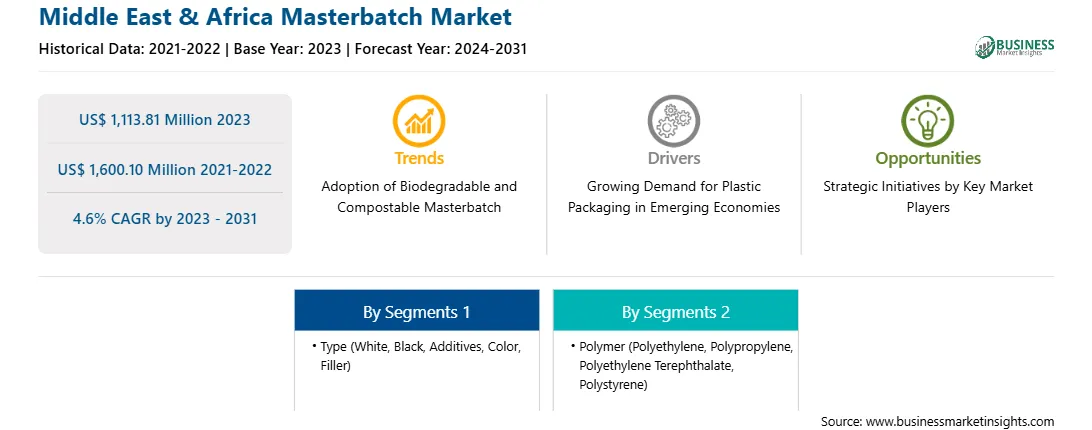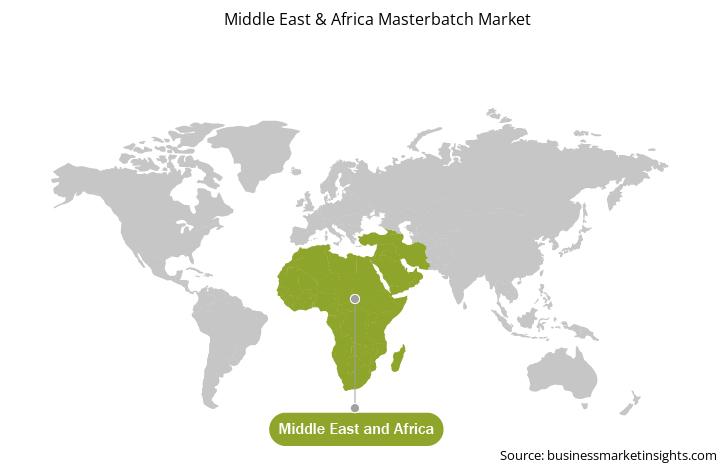The Middle East & Africa masterbatch market was valued at US$ 1,113.81 million in 2023 and is expected to reach US$ 1,600.10 million by 2031; it is estimated to register a CAGR of 4.6% from 2023 to 2031.
Bio-based polymers are environmentally friendly and are the subject of extensive research in various fields. Biodegradable materials exhibit sustainability, thereby driving their use in commercial applications. The easy availability of natural raw materials for the production of biodegradable polymers is an added factor fueling its supply and demand. Further, increasing awareness regarding environmental concerns such as plastic pollution and waste management propels the demand for sustainable alternatives to conventional plastics. Biodegradable and compostable masterbatch offer solutions to mitigate environmental impact by reducing plastic waste and promoting circular economy principles.
Stringent government regulations pertaining to the utilization of toxic chemicals across the world have encouraged many market players to develop nontoxic and biodegradable alternatives, aiding global sustainability goals. Key market players are also focused on the development of technology to produce a post-consumer recyclate carrier resin. Masterbatches can also be produced using a post-consumer recyclate carrier resin to enable recyclates and articles to be produced with the minimum virgin polymer content. In 2023, Braskem and Engeflex developed a masterbatch composed of 100% Wenew post-consumer recycled resin. By 2025, the company aims to enhance its product portfolio by ~300,000 metric tons of products with recycled content. In 2030, the company aims to dispose of ~1.5 million metric tons of plastic waste for incineration and landfills. Thus, the development of biodegradable and compostable masterbatch is expected to positively influence the Middle East & Africa masterbatch market in the coming years.
An upsurge in infrastructural projects, sustainable construction, and industrialization in the Middle East & Africa drives the demand for construction materials. As per the International Trade Administration, the construction sector's value in the UAE is expected to grow by 4.7% per annum in the next five years. The growth can be attributed to the increasing construction initiatives. The rising need for residential and commercial buildings in the Middle East & Africa bolsters the growth of the architectural paints & coatings industry. As per the Packaging Council of South Africa (Packaging SA), South Africa consumed ~3.84 million metric tons of packaging made of glass, paper, metal, and plastic, in 2022.
Increasing government initiatives and investments in charging infrastructure foster the penetration of electric vehicles in the Middle East & Africa. In 2023, Saudi Arabia's Public Investment Fund (PIF) partnered with the Saudi Electricity Company (SEC) to develop an electric vehicle infrastructure. The company aims to establish its presence in more than 1,000 locations and install 5,000 chargers across the country by 2030. Color masterbatches are widely used in the electronics industry to color wires, lighting fixtures, and electric components. Moreover, in the packaging industry, coloring masterbatches are used to color plastic packaging and caps and closures. Thus, developments in the end-use industries fuel the demand for masterbatches in the Middle East & Africa.
Strategic insights for the Middle East & Africa Masterbatch provides data-driven analysis of the industry landscape, including current trends, key players, and regional nuances. These insights offer actionable recommendations, enabling readers to differentiate themselves from competitors by identifying untapped segments or developing unique value propositions. Leveraging data analytics, these insights help industry players anticipate the market shifts, whether investors, manufacturers, or other stakeholders. A future-oriented perspective is essential, helping stakeholders anticipate market shifts and position themselves for long-term success in this dynamic region. Ultimately, effective strategic insights empower readers to make informed decisions that drive profitability and achieve their business objectives within the market.

| Report Attribute | Details |
|---|---|
| Market size in 2023 | US$ 1,113.81 Million |
| Market Size by 2031 | US$ 1,600.10 Million |
| Global CAGR (2023 - 2031) | 4.6% |
| Historical Data | 2021-2022 |
| Forecast period | 2024-2031 |
| Segments Covered |
By Type
|
| Regions and Countries Covered | Middle East and Africa
|
| Market leaders and key company profiles |
The geographic scope of the Middle East & Africa Masterbatch refers to the specific areas in which a business operates and competes. Understanding local distinctions, such as diverse consumer preferences (e.g., demand for specific plug types or battery backup durations), varying economic conditions, and regulatory environments, is crucial for tailoring strategies to specific markets. Businesses can expand their reach by identifying underserved areas or adapting their offerings to meet local demands. A clear market focus allows for more effective resource allocation, targeted marketing campaigns, and better positioning against local competitors, ultimately driving growth in those targeted areas.

The Middle East & Africa masterbatch market is categorized into type, polymer, end-use industry, and country.
Based on type, the Middle East & Africa masterbatch market is divided into white, black, additives, color, filler, and others. The white segment held the largest Middle East & Africa masterbatch market share in 2023.
In terms of polymer, the Middle East & Africa masterbatch market is segmented into polyethylene, polypropylene, polyethylene terephthalate, polystyrene, and others. The polyethylene segment held the largest Middle East & Africa masterbatch market share in 2023.
By end-use industry, the Middle East & Africa masterbatch market is divided into building and construction, automotive, packaging, agriculture, electrical and electronics, and others. The packaging segment held the largest Middle East & Africa masterbatch market share in 2023.
By country, the Middle East & Africa masterbatch market is categorized into Saudi Arabia, the UAE, South Africa, and the Rest of Middle East & Africa. Saudi Arabia dominated the Middle East & Africa masterbatch market share in 2023.
Avient Corp, Ampacet Corporation, Cabot Corp, LyondellBasell Industries NV, and FRILVAM SPA are some of the leading companies operating in the Middle East & Africa masterbatch market.
The Middle East & Africa Masterbatch Market is valued at US$ 1,113.81 Million in 2023, it is projected to reach US$ 1,600.10 Million by 2031.
As per our report Middle East & Africa Masterbatch Market, the market size is valued at US$ 1,113.81 Million in 2023, projecting it to reach US$ 1,600.10 Million by 2031. This translates to a CAGR of approximately 4.6% during the forecast period.
The Middle East & Africa Masterbatch Market report typically cover these key segments-
The historic period, base year, and forecast period can vary slightly depending on the specific market research report. However, for the Middle East & Africa Masterbatch Market report:
The Middle East & Africa Masterbatch Market is populated by several key players, each contributing to its growth and innovation. Some of the major players include:
The Middle East & Africa Masterbatch Market report is valuable for diverse stakeholders, including:
Essentially, anyone involved in or considering involvement in the Middle East & Africa Masterbatch Market value chain can benefit from the information contained in a comprehensive market report.